
Bourbon carries a history as rich and nuanced as its flavor profile.
The quintessential American whiskey, bourbon is defined primarily by its recipe, which must contain at least 51% corn, with the remainder typically made up of rye, barley, or wheat. It must be aged in new, charred oak barrels to develop its distinctive character.
The name "bourbon" originates from Bourbon County in Kentucky, a state that plays a central role in the production of this spirit. The term began to be used around 1850, though the exact origin of the name remains unclear.
Although bourbon can be produced anywhere in the United States, Kentucky is often considered its birthplace.
Over the years, bourbon production has grown significantly, representing a substantial part of the American spirits industry. The production volume reaches hundreds of millions of liters per year.
In this article, we will delve into the origins of American whiskey, with a special focus on bourbon and its craftsmanship.
How Did American Whiskey Originate?
The story of American whiskey begins with the arrival of English and Scottish settlers on the new continent. In the early 18th century, successive famines in Ireland and Scotland forced many inhabitants to migrate to America, where they intensified the cultivation of grains already grown by Native Americans, particularly rye and corn. The settlers also brought with them their stills and expertise in distillation.
Two Legendary Figures Behind the Birth of Bourbon
While the exact origin of bourbon remains uncertain, this spirit gained popularity toward the end of the 18th century.
Some credit Elijah Craig as the father of bourbon. This Baptist preacher from Virginia is often mentioned as a pioneering figure. In 1789, a fire allegedly damaged his mill, charring his oak barrels, which altered the flavor of his corn whiskey.
Others attribute the creation of bourbon to George Thorpe, an English settler who, according to legend, was the first to distill corn whiskey on American soil in the fall of 1620 in Gloucester County, Virginia. It is said that Thorpe brewed a simple beer using the corn he obtained from the Powhatan Indians, which he then distilled, aging it in American oak barrels to create a corn-based spirit.
The First Industrial Revolution Boosts Bourbon
In the 19th century, the development of railroads across the United States significantly propelled the commercialization of bourbon.
On May 10, 1868, the joining of the two lines of the Transcontinental Railroad, connecting the East and West coasts, marked a major turning point. Bourbon could now be transported nationwide, gradually replacing other widely consumed spirits, such as Apple Jack—an alcohol made from distilled hard cider—and rum, particularly popular in the East.
Prohibition: A Major Blow to American Whiskey
In 1920, the adoption of the National Prohibition Act, also known as the Volstead Act, by President Woodrow Wilson marked the peak of decades of temperance movements.
This act, enforcing the 18th Amendment to the United States Constitution, instituted a nationwide ban on alcohol in the United States until 1933.
The amendment stated that no person shall “manufacture, sell, barter, transport, import, export, deliver, or furnish intoxicating liquors except as authorized by law.”
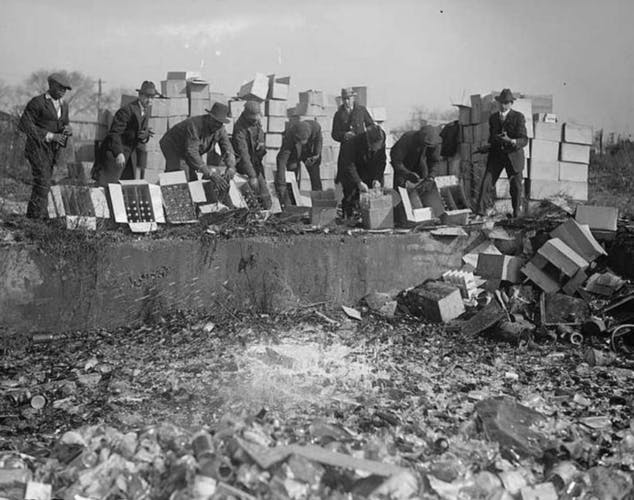
Nearly three thousand distilleries were forced to shut down, except for a few that obtained state licenses allowing them to continue producing alcohol for medicinal purposes.
Ironically, Prohibition ultimately stimulated the underground production of alcohol.
This period also saw the rise of moonshine—a low-quality, illegal spirit made using makeshift stills. By 1930, there were as many as 300,000 illicit stills in operation.
Prohibition also led to the emergence of illegal bars, known as speakeasies, where people could consume alcohol away from prying eyes.
This era inspired many stories and fantasies, fueling a rich body of work in film, literature, and other art forms, reflecting its impact on American culture.
The repeal of Prohibition by President Franklin Roosevelt in 1933 allowed distilleries to resume the production of American whiskey.
Bourbon, however, struggled to regain its former popularity.
After Prohibition ended, bourbon distilleries quickly sought to restart their operations but faced numerous challenges. They not only had to rebuild their often dilapidated or outdated facilities but also needed to restore the image of bourbon, which had become associated with the low-quality, illicit alcohol of the Prohibition era, and recapture a public whose tastes had evolved.
Some distilleries managed to stand out by swiftly resuming production, such as Buffalo Trace, which survived Prohibition by producing medicinal whiskey.
1964: The Beginning of Bourbon's Rise
In 1964, the U.S. Congress officially recognized bourbon as a "distinctive product of the United States," paying homage to its unique role in American history and culture. This designation aimed to highlight the nation's signature drink at a time when Scotch whisky dominated the American market.
In 2007, a more formal recognition was established when Senator Jim Bunning declared September as National Bourbon Heritage Month. Bourbon was now officially termed "America's Native Spirit," replacing the legal designation of "distinctive product of the United States" from 1964.
3 Crucial Steps in Bourbon Making
Grain Selection: A Critical First Step
Most American whiskeys are crafted using a blend (the mash bill) of three grains: corn, rye, and malted barley.
Corn, the primary grain in bourbon, must make up at least 51% of the recipe. It is often complemented with varying amounts of rye, which adds a dry and spicy character, or wheat, which offers a rounder and sweeter profile.
Malted barley is mainly used for its enzymes, which are essential for mashing, and it typically makes up around 10% of the recipe, contributing minimally to the flavor profile.
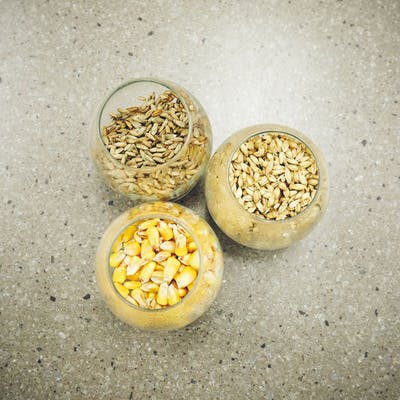
The Mash Bill Composition: Defining the Flavors and Aromas of Bourbon
The mash bill composition plays a crucial role in shaping the flavors and aromas of bourbon. Each distillery crafts its own mash bill to highlight the different taste and aromatic nuances of the grains, thus defining the unique profile of their bourbon.
Distillation Method
Bourbon is typically produced using column still distillation, the most common method among major historic producers.
This method allows for the production of larger quantities of alcohol and results in a more consistent distillate, reaching around 80% ABV. Regulations require the alcohol to be reduced to a maximum of 62.5% ABV before it is placed in barrels.

Double Distillation in Pot Stills: A Rare Method in Bourbon
Double distillation using pot stills is quite rare in bourbon production and is mainly used by small craft distilleries. Bourbon distilled this way often exhibits a richer and more complex character. The alcohol by volume (ABV) at the pot still's output typically ranges between 60% and 70%.
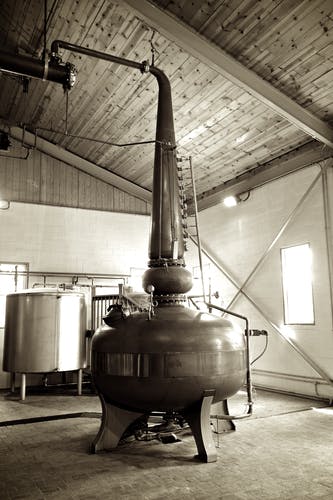
Aging Process: A Crucial Step in Developing Bourbon's Flavors
Aging is a critical phase in highlighting the flavors and aromas of bourbon.
First, distilleries are required to use new oak barrels, typically 200-liter barrels. These barrels undergo a charring process, where the inside of the barrel is carbonized.
During this process, the starch in the wood transforms into a thin caramelized layer lining the inside of the barrel.
There are four levels of charring. The higher the char level, the more significant the barrel's influence on the whiskey. This interaction enhances the extraction of color and flavors, enriching the bourbon with creamy notes like vanilla, caramel, and toffee, and giving it an amber hue.
Essential Distilleries and Brands
Today, over 95% of American whiskey is produced by a few major distilleries, such as Buffalo Trace, Jim Beam, and Heaven Hill. However, certain brands and distilleries stand out due to their innovation, the quality of their production, and their historical significance.
Michter's: A Pioneer of American Whiskey
Originally known as Shenk's before becoming Bomberger's, the distillery that would later adopt the name Michter's was founded by John Shenk, a Swiss farmer, in 1753 in Pennsylvania.
This distillery initially specialized in producing rye whiskey, a highly valued grain widely cultivated in the Blue Mountain Valley of Pennsylvania, where the distillery was located.
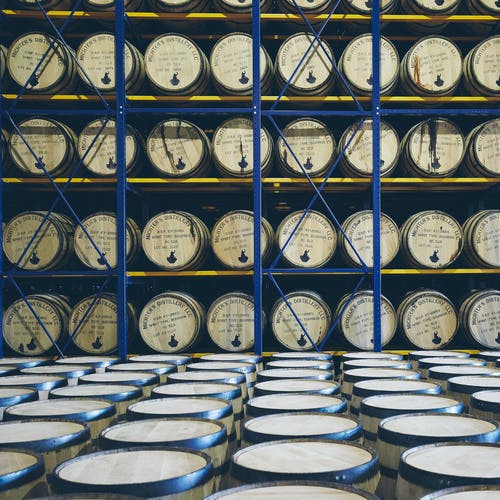
In 1950, the distillery was officially renamed Michter's. Like many other American distilleries, Michter's faced challenging times, undergoing multiple ownership changes, relocations, temporary closures, and near bankruptcy.
In the 1990s, the distillery was closed, but Michter's was revived by two whiskey industry veterans, Richard Newman and Joseph Magliocco, who successfully breathed new life into the brand. The production was entrusted to a duo of master distillers, and the distillery was relocated to the heart of Kentucky, the iconic state for American whiskey production.
Willett: A Benchmark in American Whiskey
In 1936, Thomson Willett, then 27 years old, laid the foundations of what would become Willett Distillery in Bardstown, Kentucky.
Located near the family farm purchased by his father, Lambert Willett, the distillery quickly became a post-Prohibition whiskey benchmark, maintaining its independence and family character to this day.
By the following spring in 1937, the first whiskey productions began, marking a promising future for Kentucky Bourbon aged in the distillery's uniquely situated warehouses.
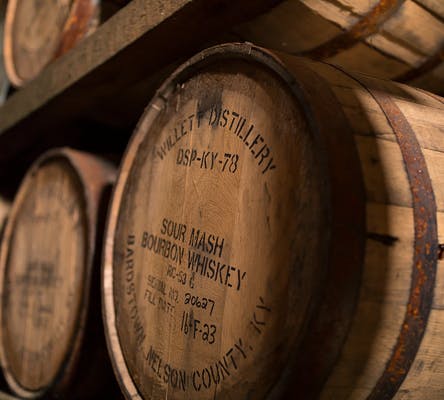
The art of distillation is not merely a profession but a true tradition within the Willett family, with records showing a passion for whiskey dating back to the second half of the 19th century. Today, the fifth generation of the Willett family continues this legacy, skillfully blending ancestral techniques with modern innovations to produce renowned bourbon and rye whiskey.
A major turning point in Willett Distillery's history occurred in 2012, 32 years after the original facility's closure, when the Willett-Kulsveen family revived the Willett Distilling Company.
Staying true to their family tradition, the distillery now produces 100% of the whiskies bottled under its brand on-site, demonstrating an unwavering commitment to quality and authenticity.
Blanton’s: The Bourbon That Revolutionized American Whiskey
Blanton's, the first single barrel bourbon, was introduced in 1983, forever changing the American whiskey industry.
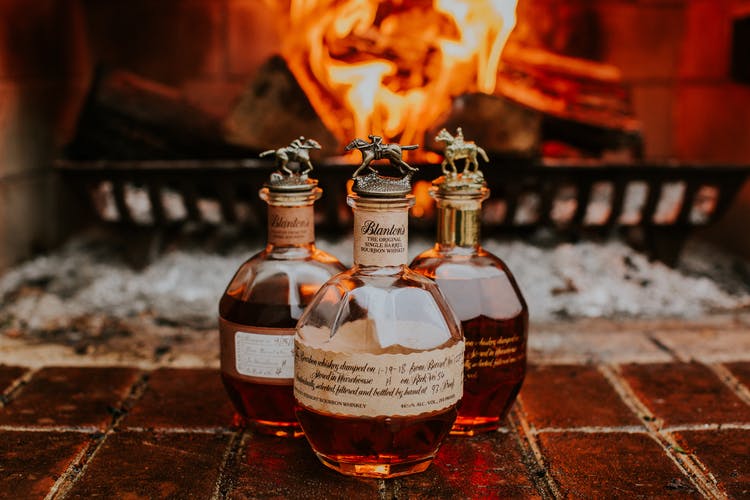
This story begins in the heart of Kentucky, at Buffalo Trace, a pioneering distillery in American whiskey.
Blanton's bourbon is named after Colonel Albert B. Blanton, who led the distillery from 1912 to 1953. Under his leadership, the distillery was not just a place for whiskey production but a true innovation lab.
Each barrel of Blanton's is aged at its own pace and bottled individually by hand, allowing the brand's many enthusiasts to discover unique aromas and flavors with each bottle.
Every bottle is an exploration, a journey through the subtle nuances that only a bourbon of this quality can offer.
TO EXPLORE WHISKIES FURTHER
La Maison du Whisky has three stores in Paris:
- 6 Carrefour de l'Odéon, 75006 Paris
- 11 rue Tiquetonne, 75002 Paris
In each of these stores, you can discover a wide range of whiskies, rums, sakes, and other spirits.
Because a whisky can be described in a thousand words, our advisors will be delighted to introduce you to the must-try American whiskeys available at La Maison du Whisky.
Check our tasting schedule for upcoming events, or visit the Golden Promise Whisky Bar, which offers a wide selection of whiskies and other spirits by the glass.